Edgars Vinters
Edgars Vinters (September 22, 1919 – April 29, 2014) was a Latvian painter.[1]
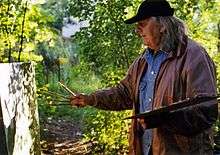
Life
Born in Riga, Edgars Vinters was the only child of the facade and decoration painter Hermanis Vinters (1874–1939) and his wife Anna, née Kalniņa, (1879–1953). As a ten-year-old boy he met with the popular pastelist Voldemārs Irbe, who detected the boy’s talent, taught him the basics of pastel painting and opened his eyes to the beauty of nature in its so-called minor details. From 1935 on, he wrote small articles for children's and youth magazines, which he illustrated with pen and ink drawings and linocuts.[2] With the money he made, he contributed to the school fee for the commercial college he attended until 1940, after a change of school.
Resulting from contact he made with the painter Hugo Kārlis Grotuss, from 1937 Vinters changed his painting style. Grotuss encouraged him to give up ‘the dark phase’ he was in through Irbe, to use brighter primers and to show more briskness and colours in his paintings. A porcelain factory engaged him to paint a series of porcelain plates for president Kārlis Ulmanis.
After he had taken his high-school-diploma, he joined the Latvian Art Academy and until 1944 studied under the professors Jānis Kuga, Leo Svemps, Jānis Cielavs, Valdemārs Tone, Jānis Annuss, Kārlis Miesnieks und Vilhelms Purvītis. In 1944, Vinters had to drop out of his studies; he was drafted for the service in the Latvian Legion and deployed near Toruń on the Vistula River. In 1945 he was taken prisoner of war by the Soviet Army and deported to a POW camp near Moscow. There Russian officers made out his artistic abilities and facilitated the establishment of an atelier. During this time Vinters made a series of drawings and paintings, which he for the first time showed to an art lover, who had worked about his life and his works and which were published in an art book in 2012. Back in Riga in 1947, he could teach art and drafting at a secondary school. At the same time, he attended Janis Rozentāls Art Highschool and got his qualifications in teaching in 1949.
Work
Vinters painted objectively, mostly landscape painting. Early works from childhood and youth were made with pencil and ink pen; later, for a short time he made linocuts and pastel works and then found his means of painting, his favorite being oil painting. Frequently in his craft he made aquarelles and, as a speciality during the 1970s, monotypes. But oil painting remained his prime means of expression for his interpretations of his beloved Latvian landscapes during the seasons, of flowers and townscapes.
During the time of the German occupation, Vinters published drawings and aquarelles in German Journals.[3]
During the Soviet period, his exhibitions were confined to Riga and other cities of the Latvian Socialist Soviet Republic. After the liberation of Latvia in 1991 his art increasingly found attention and appreciation.[4] Periodically exhibitions were organized in Latvia; later, beginning in 1993, in the UK and the USA, and from 2006 in Germany.[5] Increasingly, his works are presented by the art trade worldwide.
During a state visit by Turkish President Abdullah Gül on April 2, 2013 in Latvia, the Latvian President Andris Bērziņš presented to the Turkish presidential couple as a gift a painting of Edgars Vinters.
Private life
In 1951 Vinters married Helma Krause, a teacher and colleague. Their only child son Ilmārs was born in 1958. Vinters was buried on May 2, 2014 at the 1st Riga Forest Cemetery in the northeastern part of Riga at the side of his mother.
Awards
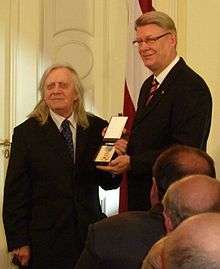
On November 16, 2009 Edgars Vinters was awarded the Order of the Three Stars by President Valdis Zatlers in recognition of his lifetime achievement.[6]
Selected works
- Gallery
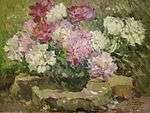 Edgars Vinters, Peonies, Oil on cardboard; 70 x 90 cm, 1997 (Hans Joachim Gerber collection)
Edgars Vinters, Peonies, Oil on cardboard; 70 x 90 cm, 1997 (Hans Joachim Gerber collection)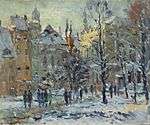 Edgars Vinters, An afternoon at the lower and upper guild, Riga, Oil on cardboard; 80 x 95 cm, 1975(Hans Joachim Gerber collection)
Edgars Vinters, An afternoon at the lower and upper guild, Riga, Oil on cardboard; 80 x 95 cm, 1975(Hans Joachim Gerber collection)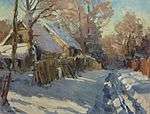 Edgars Vinters, Winter sun in Līči near lake „Juglas ezers“ , Oil on cardboard; 76 x 96 cm, 1970 (Hans Joachim Gerber collection)
Edgars Vinters, Winter sun in Līči near lake „Juglas ezers“ , Oil on cardboard; 76 x 96 cm, 1970 (Hans Joachim Gerber collection)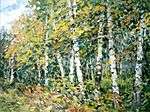 Edgars Vinters, My birch trees in summer, Oil on cardboard 65 x 87 cm, 2001 (Hans Joachim Gerber collection)
Edgars Vinters, My birch trees in summer, Oil on cardboard 65 x 87 cm, 2001 (Hans Joachim Gerber collection)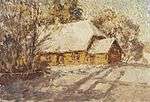 Edgars Vinters, House ’Braki’ of poet Rūdolfs Blaumanis in Winter, Monotype, 43 x 61, 1971 (Hans Joachim Gerber collection)
Edgars Vinters, House ’Braki’ of poet Rūdolfs Blaumanis in Winter, Monotype, 43 x 61, 1971 (Hans Joachim Gerber collection)
Sources
- Hans Joachim Gerber, Ojārs Spārītis: Der lettische Maler Edgars Vinters. Editor: Zvaigzne ABC, Riga 2009. (ISBN 978-9934-0-0755-2; Illustrated biography, German language).
- Hanss Joahims Gerbers, Ojārs Spārītis: Gleznotājs Edgars Vinters. Editor: Zvaigzne ABC, Riga 2009. (ISBN 978-9934-0-0756-9; The Latvian edition of the biography).
- Günter Grass, Ojārs Spārītis, Hans Joachim Gerber: Es vēlos mājās pārnākt. Edgars Vinters. Editor: Zvaigzne ABC, Riga 2012 (ISBN 978-9934-0-3231-8; Drawings of a soldier; four languages: Latvian / English / German / Russian).
- Hans Joachim Gerber, Ojārs Spārītis: Edgars Vinters - gaisma, krāsas, noskaņas / Licht, Farben, Stimmungen [Latvian and German] Apgāds Zvaizne, Riga 2019, ISBN 978-9934-0-8452-2
Edgars Vinters Studio in Dunte
On June 10, 2017 the Edgars Vinters Studio (Edgara Vintera studija) has been opened in Dunte / Latvia. In an annex to the Munchausen Museum oil paintings, watercolors and monotypes show examples of Edgars Vinters' life work. In addition, a series of photos describes the life of the artist, film excerpts show the artist painting 'pleinair'.[7]
External links
- Priekš Latvijas - VISU! (Vinters as plain air painter). 1998, Latvian film of Ilmārs Krū Zakss (1939-2008)
References
| Wikimedia Commons has media related to Edgars Vinters. |
- Notes
- DELFI. "Mūžībā aizgājis gleznotājs Edgars Vinters - DELFI". Delfi.lv. Retrieved 2014-05-01.
- Journal Cīrulītis, 1934 to 1938:
- Pen drawing of fifteen year old Edgars Vinters.
- Linocut illustrating a Latvian poem (Daina): (Sadly cry the sparrows / When they see me threshing / Don't cry, little sparrows/ There still remains a lot).
- Pen drawing illustrating popular song Tumšā nakte, zaļā zālē ("Dark night, green grass").
- Pen drawing Island in lake „Baltezers“ .
- Linocut Portrait of Martin Luther.
- Linocut Portrait of composer Jāzeps Vītols.
- Journal "Deutsche Zeitung im Ostland " from December 1941 to April 1942:
- Report in daily newspaper Latvijas Avīze of May 20, 2011 about the exhibition Vinteratkusnis with 10 Fotos.
- Series of Edgars Vinters' works in Galleries:
- Topic Arī ikdienišķajā ieraudzīt skaisto(Even everyday see the beauty) in daily newspaper Latvijas Avīze of May 21, 2011 (...) Aizpērn mākslinieku E. Vinteru godināja viņa 90 gadu jubilejā, gleznotājs saņēma augstāko valsts apbalvojumu – Triju Zvaigžņu ordeni. (...two years ago, in honor of the 90th birthday of artist E. Vinters, the painter received the highest award of the state, the Order of the Three Stars)
- Website of Munchausen Museum in Dunte / Latvia (English language)